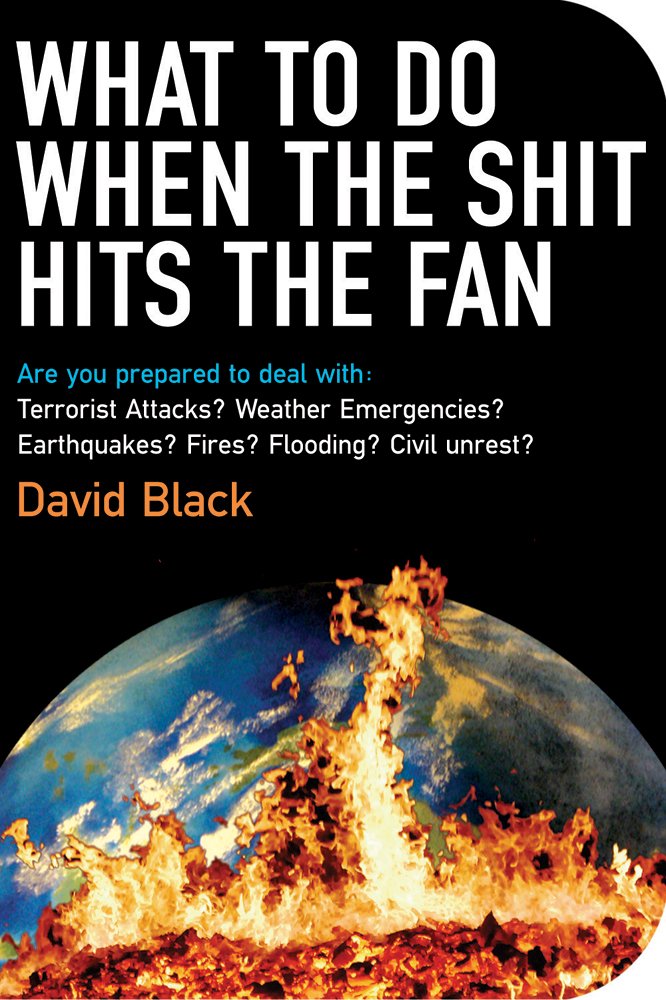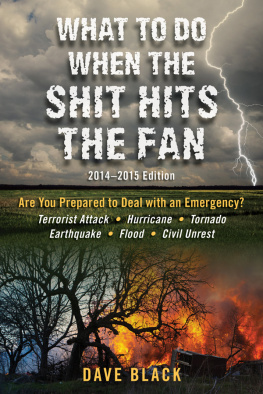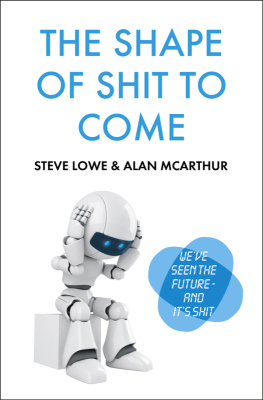David S Black - What to do when the shit hits the fan
Here you can read online David S Black - What to do when the shit hits the fan full text of the book (entire story) in english for free. Download pdf and epub, get meaning, cover and reviews about this ebook. City: New York, year: 2007, publisher: Skyhorse Pub, genre: Home and family. Description of the work, (preface) as well as reviews are available. Best literature library LitArk.com created for fans of good reading and offers a wide selection of genres:
Romance novel
Science fiction
Adventure
Detective
Science
History
Home and family
Prose
Art
Politics
Computer
Non-fiction
Religion
Business
Children
Humor
Choose a favorite category and find really read worthwhile books. Enjoy immersion in the world of imagination, feel the emotions of the characters or learn something new for yourself, make an fascinating discovery.
- Book:What to do when the shit hits the fan
- Author:
- Publisher:Skyhorse Pub
- Genre:
- Year:2007
- City:New York
- Rating:5 / 5
- Favourites:Add to favourites
- Your mark:
- 100
- 1
- 2
- 3
- 4
- 5
What to do when the shit hits the fan: summary, description and annotation
We offer to read an annotation, description, summary or preface (depends on what the author of the book "What to do when the shit hits the fan" wrote himself). If you haven't found the necessary information about the book — write in the comments, we will try to find it.
What to do when the shit hits the fan — read online for free the complete book (whole text) full work
Below is the text of the book, divided by pages. System saving the place of the last page read, allows you to conveniently read the book "What to do when the shit hits the fan" online for free, without having to search again every time where you left off. Put a bookmark, and you can go to the page where you finished reading at any time.
Font size:
Interval:
Bookmark:

www.redcross.org American Red Cross
www.salvationarmyusa.org Salvation Army
www.usafreedomcorps.gov USA Freedom Corps
www.medicalreservecorps.gov Medical Reserve Corps
www.arrl.org Amateur Radio Emergency Service (ARES)
www.races.net Radio Amateur Civil Emergency Service (RACES)
www.nvoad.org National Voluntary Organizations Active in Disaster
www.citizencorps.gov/programs/ Community Emergency Response Team Program (CERT), Medical Reserve Corps, Fire Corps, USAonWatch, Volunteers in Police Service
www.reliefweb.int the U.N. Office for the Coordination of Humanitarian AffairsCenters for Disease Control and Prevention
www.pandemicflu.gov for pandemic flu information
http://.hhs.gov/emergency/Department of Health and Human Services
http://disasterhelp/portaljhtml/index.jhtml for assistance information
http://epa.gov Environmental Protection Agency
www.fema.gov Federal Emergency Management Agency
www.travel.state.gov Department of State
www.nih.gov National Institute of Health
www.fda.gov Food and Drug Administration
www.doe.gov Department of Energy
www.fbi.gov Federal Bureau of Investigation
Federal Emergency Management Agency: 1-800-621-3362 (621-FEMA)
Federal Citizen Information Center (FCIC): 1-800-333-4636 (FED-INFO)
American Red Cross National Headquarters: 1-866-438-4636 (GET-INFO)
In a large-scale disaster it may be hours or days before an emergency response unit can respond to a hazardous materials incident that isnt producing casualties. Some simple tests can provide you with some information about the hazards of unknown substances spilled or deposited in your community. It can also tell you if the substance might present a live germ hazard (e.g., a mysterious white powder event).
Even though material is not producing casualties you should evacuate the area for several hundred feet.
Be aware that these tests provide only basic information about the hazards of the substance. The tests are not comprehensive, and there is no test to determine if a substance is poison, unless you want to feed it to your pet rat, in which case the kids will hate you.
Take appropriate precautions and use personal protective equipment if you decide to handle any of the unknown material. You only need a small sample. Take notes on what you find and give them to the responders.
- Whats the state of the material (solid, liquid, or gas)?
- What color is it?
- What consistency is it (for solids: powder, grains, chunk, etc.) and what viscosity (for liquids: like water, like oil, like cold molasses)?
- What clarity does it have (transparent, translucent, opaque)?
- Does it react when exposed to air (heat, smoke, gas, flame, etc.)? If so, its air reactive. Bad stuff .
- In a glass dish or test tube, carefully add a few drops of the unknown to a few drops of water. If theres heat, gas, or flame generated, its water reactive . Dont try to wash it away.
- Does it dissolve in water? If not:
- Does it sink or float (is it less or more dense than water)?
- Test a liquid or a dissolved solution with pH paper. If its less than 3 or greater than 12, its highly corrosive. Note: Germs (biologic agents) will not survive in low or high pH (<5 or >9).
- Use a lighter or wooden match. Touch it to a few drops or small chunks of the unknown. If it lights, pull the lighter away. If it reacts violently, its explosive . Evacuate an appropriate area . If it supports its own combustion, its flammable ( a major fire hazard ). If it goes out, hold the lighter to it for one second. If it burns, its combustible .
- Youll need some weak hydrochloric acid and some starch-iodine paper for this test. Purchase the paper commercially or have the local chemistry teacher make it for you ahead of time. Wet a tiny piece of the paper with a drop or two of the acid. Then touch it to a drop or tiny piece of the unknown. If the paper turns dark purple or black, the unknown is an oxidizer. It can react with other substances and cause or accelerate a fire. Note: oxidizers kill germs.
Note: At this point a sulfide test and a cyanide test are often done on unknowns with a pH greater than 10 to test for the presence of toxic hydrogen sulfide or cyanide. Dont bother. If the substance has a pH over 10, stay a large distance from it. A copper wire test in which a wire coated with some of the unknown is heated in a flame is also commonly performed to test for chlorides and halogens (indicated by a green flame).
So what has all this told you? Youve determined if the substance is a fire or explosion hazard and if its dangerously corrosive. Many corrosives are also respiratory hazards. You also know what will happen if you add water to the unknown in an attempt to dilute it or wash it way. And if the pH was high or low and/or its an oxidizer, its not likely that your unknown has any live germs in it. But you never know. Stay away from the stuff anyway until the professionals can test and dispose of it.
There are some problems with these tests. As mentioned before they dont tell you if a substance is poison. Some very potent acids will not show extreme pH on the strip, and some oxidizers cannot be identified with the starch-iodine paper. Germs may not survive in low or high pH or in oxidizers, but bio-toxins (e.g., ricin) might.
If nothing else, learning these tests will give you an awareness of the potential hazards of unknown substances.
Of the extreme high-rise evacuation methods mentioned in Chapter 15, its the authors opinion that rappelling and lowering are the most practical means of getting yourself and others down in a last resort situation.
Assumptions:
- Over two-thirds of high-rise fires start below the fifth floor.
- Heat and sharps (glass and metal) are the primary threats to rope evac equipment. Regular nylon, polyester, and polypropylene climbing and rescue ropes may not be able to withstand the damage.
- Smoke and operator error are the primary threats to rope evacuees.
Based on these assumptions, the following conclusions can be made:
- Most high-rise rope evacs should only require 120 feet or less of rope (20 feet per floor plus 20 feet for anchoring). If the fire is above the 5th floor, the rope can be used to get evacuees to the floors below the fire, or a rope of appropriate length can be used to land evacuees on the ground (again, 20 feet per floor, plus 20 feet for anchoring).
- Most nylon, polyester, and polypropylene ropes lose half their strength by the time they are exposed to temperatures of between 250 to 350 degrees. Testing has shown that some newer high-tensile fibers, Technora, for example, are two to three times as resistant to heat and significantly more resistant to abrasion than the fibers used in standard ropes.
Font size:
Interval:
Bookmark:
Similar books «What to do when the shit hits the fan»
Look at similar books to What to do when the shit hits the fan. We have selected literature similar in name and meaning in the hope of providing readers with more options to find new, interesting, not yet read works.
Discussion, reviews of the book What to do when the shit hits the fan and just readers' own opinions. Leave your comments, write what you think about the work, its meaning or the main characters. Specify what exactly you liked and what you didn't like, and why you think so.






![Stack - It is just you, everythings not shit: [a guide to all things nice]](/uploads/posts/book/253795/thumbs/stack-it-is-just-you-everything-s-not-shit-a.jpg)




